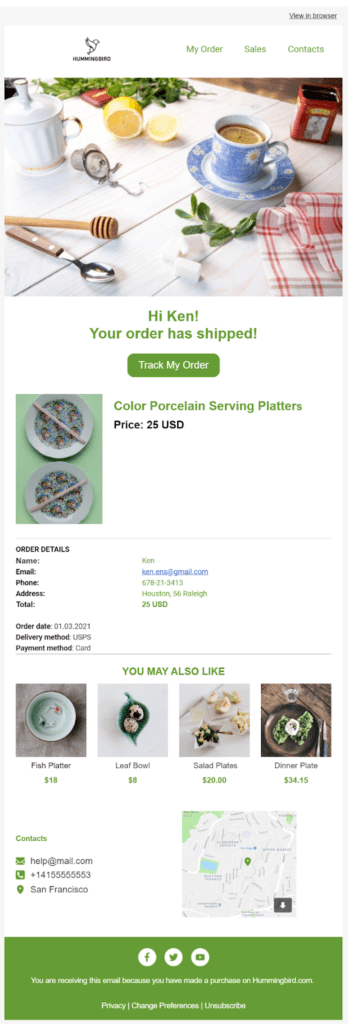In a post-Covid world, online shopping has become a regular thing even for people who have never used the Internet for anything beyond checking Wikipedia. International payment and shipment have made it possible to buy goods from almost every corner of the world.
Alongside order placement, all the purchase-related communication has also moved online. And order confirmation emails have become a significant part of retailers’ email marketing, fulfilling several important roles:
- Notify customers about the successful order placement;
- Give all the necessary order details;
- Let people know when to expect a shipment or delivery;
- Create a reputation of a trustworthy brand that doesn’t vanish after receiving the customer’s money;
- Avoid legal claims related to the order placement issues;
- Help retain clients and build a long-lasting communication with the brand;
- Deliver a good user experience;
- Upsell and produce repeat sales.
Keeping this importance in mind, marketers should create confirmations with much attention, following the best email marketing practices. Let’s see how to do it and how to use confirmation emails to drive revenue for your company.
How to Build an Order Confirmation Email
Before we dive into practical tips, I’d like you to note one thing. Though there are standard practices for creating confirmation emails, the design of your email will also depend on the type of product you’re selling, your tone of voice and overall customer communication strategies. You don’t necessarily have to follow every single piece of the below advice. Pick what’s the best for your product and your customers and optimize all techniques based on your corporate style.
A Subject Line, To Start With
Any email starts with a subject line. As a rule, subject lines serve to catch the attention and prompt the recipient to open your message. Email confirmations are different. People expect them and want to open. For order confirmation subjects, you don’t need to get extra creative or tempting. Instead, clearly specify the message’s purpose. Order Confirmation, Confirming Order #123, Your Order Has Been Shipped are optimal versions.
If you get carried away and write something like Great News! You’ve Made It or Good Choice, people may think you’re sending a regular promo and may ignore it.
If needed, you can add extra information in a preheader. A preheader is a piece of text that goes after a subject in the Inbox line. It complements the subject and provides extra details.


Depending on the device screen width and email client, a preheader display can vary, so try to stick to 30 and 55 characters to be on the safe side. Also, I’d recommend separating the subject and preheader with the rest of the email body. This way, it will look more professional and will be easier to spot. Depending on the service you use, you can separate it in the email editor or do it straight in code.
What to Include in an Order Confirmation Email
As I’ve already mentioned, the copy of your confirmation email will depend on your particular product and corporate email strategies. Below, I’ll enlist the most common confirmation email template elements (and why to add them), and you decide which are required for your particular campaigns.
- View in browser link. If the email isn’t rendered for any reason, the person can open it in a new browser tab by clicking this link. I’d recommend putting it atop.
- Company name and logo.
- Menu. It can be a website menu (taking the reader to the website) or a copy menu (taking the reader to a certain email block). Confirmation emails are rarely long, but if yours feature several sections, consider adding a copy menu.
- Banner.
- Personal greeting. A confirmation email is a transactional email sent in a response to the customer’s action, a purchase in particular. Make it sound personal and friendly as if the customer were talking to a shop assistant in a physical store. Addressing by name is an important component of this friendliness.
- Order info. Include the details applicable to the purchase: order ID, product name, image, price, order date, payment method, delivery address, delivery method, order total.
- Track My Order button. This button directs to the tracking link clicking which the customer will be able to track their shipment.
- Complementary product recommendations. You can do upselling by including in a confirmation email a block with personalized product recommendations. It can feature bestsellers, staff’s picks or products people also buy together with the ordered items.
- Company contacts. Add your phone number, email address, physical address, pickup locations, and social media accounts so that the customer can contact you the way that’s most convenient for them.
- Legal information. Depending on the customer privacy policies valid in the country/state/region your customers are located, you may need to include the following details: privacy policy, terms of use, preference updates, Unsubscribe link, the reason why you’re sending this email.
Take a look at the below template example to see how this info can be organized within an email.


Again, you don’t have to include everything. Build a template with your corporate colors and fonts, add relevant info and watch over the overall design. If you have too many product images, skip the banner to avoid visual overload. If you don’t have a physical store, you obviously won’t have a store address and map. Use common sense and meet the expectations of your readers first.
When to Send
An order confirmation should be sent straight after the order has been placed. To do this, you need to choose a professional email provider that can receive and process big amounts of data and trigger the corresponding emails fast. The following functionality would be an extra benefit:
- Real-time data receiving;
- Integration with external CRMs;
- Fast event processing;
- Omnichannel workflows;
- Customer segmentation based on order conditions;
- Analysis of opens and clicks.
When set properly, these features will let you send personalized confirmations in time based on the customer’s behavior and purchase history.
To Sum Up
For retailers, an order confirmation email is an important element of email marketing strategies. It delivers the order details in time, serves as proof of your brand’s trustability, generates repeat sales, and contributes to customer retention. If you’re an ecommerce without physical stores, emails are the only way you can communicate with your customers. Make this communication convenient for people and you’ll be able to enjoy their loyalty long after the initial purchase.


Author
Iuliia Nesterenko is a technical writer at eSputnik. Her focus is on exploring current digital marketing trends and describing new strategies for email marketers.








Leave a Reply
View Comments